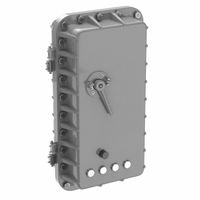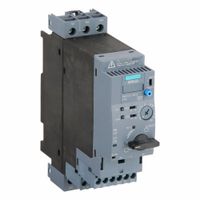Call +(254) 703 030 000 / 751 483 999 / 721 704 777
- Home
- Electrical
- Motor Controls
- Motor Starters Combination Starters
- Motor Starters
.....Read More
Frequently Asked Questions
What is a motor starter and how does it work?
A motor starter is an electrical device used to start and stop a motor safely and efficiently. It provides the necessary current to start the motor and offers protection against overloads and short circuits. Motor starters are essential for controlling the power flow to the motor, ensuring it operates within safe parameters.
Motor starters typically consist of two main components: a contactor and an overload relay. The contactor is an electrically controlled switch that connects and disconnects the power supply to the motor. It is activated by a control circuit, which can be operated manually or automatically. The contactor's coil, when energized, closes the contacts, allowing current to flow to the motor.
The overload relay is a protective device that monitors the current flowing to the motor. If the current exceeds a predetermined level, indicating an overload condition, the relay trips, opening the contactor and disconnecting the power to prevent damage to the motor. Overload relays can be thermal or electronic, with thermal relays using bimetallic strips that bend with heat and electronic relays using sensors to detect current levels.
Motor starters can be classified into several types, including direct-on-line (DOL) starters, star-delta starters, and soft starters. DOL starters apply full voltage to the motor terminals, providing a simple and cost-effective solution for small motors. Star-delta starters reduce the initial voltage, minimizing inrush current and mechanical stress on larger motors. Soft starters gradually increase the voltage, providing a smooth start and reducing electrical and mechanical stress.
In summary, a motor starter is crucial for the safe operation of electric motors, providing control, protection, and efficient power management.
What are the differences between IEC and NEMA motor starters?
IEC (International Electrotechnical Commission) and NEMA (National Electrical Manufacturers Association) motor starters differ primarily in design standards, application, and performance characteristics:
1. **Design Standards**:
- **IEC**: Focuses on global standards, emphasizing compact design and efficiency. IEC starters are typically smaller and lighter, designed for modularity and ease of integration.
- **NEMA**: Primarily used in North America, NEMA standards prioritize robustness and durability. NEMA starters are generally larger and more rugged, designed to handle more severe conditions.
2. **Performance and Ratings**:
- **IEC**: Ratings are based on utilization categories (e.g., AC-1, AC-3), which define the type of load and duty cycle. IEC starters are designed for specific applications, offering precise control and efficiency.
- **NEMA**: Ratings are based on horsepower and voltage, with a focus on overcurrent protection and thermal capacity. NEMA starters are versatile, suitable for a wide range of applications without specific load categorization.
3. **Application and Usage**:
- **IEC**: Commonly used in applications where space is limited and efficiency is critical. They are ideal for environments with less severe operating conditions.
- **NEMA**: Preferred in heavy-duty applications, such as industrial settings, where reliability and durability are crucial. They are suitable for harsh environments and high-stress conditions.
4. **Cost and Availability**:
- **IEC**: Generally more cost-effective due to their compact size and efficient design. Widely available in international markets.
- **NEMA**: Typically more expensive due to their robust construction. Predominantly available in North America.
5. **Customization and Flexibility**:
- **IEC**: Offers modular components, allowing for easy customization and integration into complex systems.
- **NEMA**: Provides standardized components, ensuring compatibility and ease of replacement in existing systems.
How do you choose the right motor starter for an application?
1. **Motor Specifications**: Determine the motor's voltage, current, power rating, and type (AC or DC). This information is crucial for selecting a compatible starter.
2. **Load Characteristics**: Understand the load type (e.g., constant, variable, or high starting torque) and its impact on the motor. This helps in choosing a starter that can handle the load requirements.
3. **Starting Method**: Decide on the starting method based on application needs. Options include direct-on-line (DOL), star-delta, autotransformer, soft starters, and variable frequency drives (VFDs). Each method has different implications for starting current, torque, and cost.
4. **Control Requirements**: Consider the control features needed, such as overload protection, short-circuit protection, and remote control capabilities. Ensure the starter has the necessary control functions.
5. **Environmental Conditions**: Evaluate the operating environment, including temperature, humidity, and exposure to dust or corrosive substances. Choose a starter with appropriate enclosure ratings (e.g., NEMA or IP ratings) for protection.
6. **Regulatory Compliance**: Ensure the starter complies with relevant standards and regulations, such as IEC, NEMA, or local electrical codes.
7. **Cost and Efficiency**: Balance the initial cost with operational efficiency and energy savings. Some starters, like VFDs, offer energy efficiency benefits that can offset higher upfront costs.
8. **Space Constraints**: Consider the physical size of the starter and available installation space. Compact starters may be necessary for limited spaces.
9. **Maintenance and Reliability**: Choose a starter with a proven track record for reliability and ease of maintenance. Consider the availability of spare parts and technical support.
10. **Future Scalability**: If future expansion or changes are anticipated, select a starter that can accommodate increased capacity or different motor types.
What are the types of motor starters available?
1. **Direct-On-Line (DOL) Starter**: The simplest type, directly connects the motor to the power supply. Suitable for small motors, it provides full voltage to the motor terminals.
2. **Star-Delta Starter**: Used for reducing the starting current of the motor. It initially connects the motor in a star configuration, then switches to a delta configuration for normal operation.
3. **Autotransformer Starter**: Utilizes an autotransformer to reduce the initial voltage applied to the motor, thereby reducing the starting current. Suitable for large motors.
4. **Soft Starter**: Uses solid-state devices to gradually increase the voltage to the motor, providing a smooth start. It reduces mechanical stress and electrical peak demand.
5. **Variable Frequency Drive (VFD)**: Controls the motor speed and torque by varying the motor input frequency and voltage. Offers precise control and energy efficiency.
6. **Resistor Starter**: Introduces resistors in series with the motor windings to limit the starting current. Once the motor reaches a certain speed, the resistors are bypassed.
7. **Reversing Starter**: Allows the motor to run in both forward and reverse directions by changing the phase sequence of the motor supply.
8. **Slip Ring Induction Motor Starter**: Specifically for slip ring motors, it uses external resistors connected to the rotor circuit to control the starting current and torque.
9. **Solid-State Starter**: Similar to soft starters, these use thyristors to control the voltage applied to the motor, providing a smooth start and stop.
10. **Manual Motor Starter**: A simple, manually operated switch that provides basic on/off control and overload protection for small motors.
How do motor starters protect motors from damage?
Motor starters protect motors from damage through several key functions:
1. **Overload Protection**: Motor starters include overload relays that monitor the current flowing to the motor. If the current exceeds a preset limit, indicating an overload condition, the relay trips and disconnects the power supply, preventing overheating and potential damage to the motor windings.
2. **Short Circuit Protection**: Motor starters often incorporate circuit breakers or fuses that protect against short circuits. These devices quickly interrupt the power supply if a short circuit occurs, preventing excessive current flow that could cause severe damage to the motor and associated wiring.
3. **Under-voltage Protection**: Some motor starters are equipped with under-voltage protection features. If the supply voltage drops below a certain level, the starter disconnects the motor to prevent it from operating under insufficient voltage conditions, which can lead to overheating and reduced efficiency.
4. **Phase Failure and Imbalance Protection**: For three-phase motors, starters can detect phase failure or imbalance. If one phase is lost or the phases are imbalanced, the starter will disconnect the motor to prevent damage due to uneven load distribution and overheating.
5. **Soft Starting and Stopping**: Motor starters can include soft start and stop features, which gradually increase or decrease the voltage to the motor. This reduces mechanical stress and electrical surges during startup and shutdown, extending the motor's lifespan.
6. **Thermal Protection**: Thermal overload relays within the starter detect excessive heat generated by the motor. If the temperature exceeds safe levels, the relay trips to cut off power, preventing thermal damage.
By incorporating these protective measures, motor starters ensure the safe and efficient operation of motors, minimizing the risk of damage and prolonging their operational life.
What is the role of overload relays in motor starters?
Overload relays play a critical role in motor starters by providing protection against excessive current, which can cause overheating and damage to electric motors. They are designed to sense the current flowing to the motor and disconnect the power supply if the current exceeds a predetermined level for a specific period. This helps prevent motor burnout and extends the lifespan of the motor.
There are two main types of overload relays: thermal and electronic. Thermal overload relays use a bimetallic strip that bends when heated by excessive current, triggering a trip mechanism to open the circuit. Electronic overload relays, on the other hand, use current sensors and microprocessors to monitor current levels and provide more precise protection.
Overload relays are typically integrated into motor starters, which are devices that combine a contactor and overload protection in a single unit. The contactor is responsible for switching the motor on and off, while the overload relay ensures the motor operates within safe current limits.
The key functions of overload relays in motor starters include:
1. **Protection**: They protect motors from damage due to overcurrent conditions, such as mechanical jams or excessive load.
2. **Automatic Reset**: Some overload relays offer automatic reset features, allowing the motor to restart once normal conditions are restored.
3. **Adjustability**: They often allow for setting the trip current level to match the motor's specifications, providing tailored protection.
4. **Phase Loss Protection**: Many overload relays can detect phase loss, which can cause severe motor damage, and trip the circuit to prevent it.
Overall, overload relays are essential for ensuring the safe and efficient operation of motors by preventing overheating and potential failures.
How do you troubleshoot common issues with motor starters?
1. **Visual Inspection**: Check for physical damage, loose connections, or burnt components. Ensure all wires are properly connected and that there are no signs of overheating.
2. **Power Supply**: Verify that the motor starter is receiving the correct voltage. Use a multimeter to check the input power and ensure it matches the motor's requirements.
3. **Control Circuit**: Inspect the control circuit for issues. Check the start and stop buttons, overload relays, and any auxiliary contacts for proper operation.
4. **Overload Relay**: Ensure the overload relay is set correctly for the motor's full-load current. Reset the relay if it has tripped and investigate the cause of the overload.
5. **Contactors**: Examine the contactor for wear or pitting on the contacts. Ensure the contactor coil is receiving the correct voltage and that it engages and disengages properly.
6. **Fuses and Circuit Breakers**: Check for blown fuses or tripped circuit breakers. Replace any faulty fuses and reset breakers as needed.
7. **Motor Connections**: Verify that the motor connections are tight and correct. Check for any signs of insulation damage or corrosion.
8. **Testing Components**: Use a multimeter to test individual components like coils, contacts, and relays for continuity and resistance.
9. **Grounding**: Ensure the motor and starter are properly grounded to prevent electrical faults.
10. **Environmental Factors**: Consider environmental conditions such as temperature, humidity, and dust, which may affect the starter's performance.
11. **Consult Documentation**: Refer to the motor starter's manual for specific troubleshooting steps and specifications.
12. **Professional Help**: If the issue persists, consult a professional electrician or technician for further diagnosis and repair.



